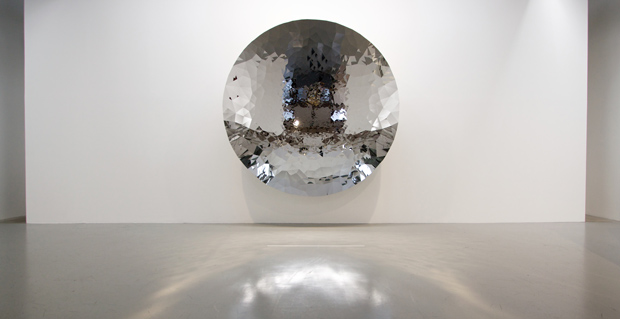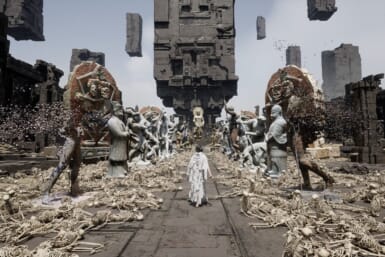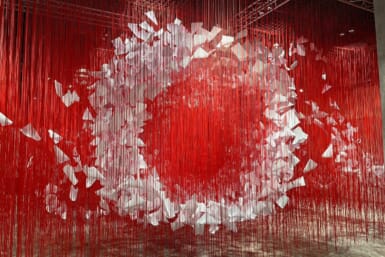by Owen Schaefer
It was several years ago, the first time I ran across one of Anish Kapoor’s many Void sculptures. The work had been coated in a black pigment so utterly non-reflective that even in the lights of the gallery it could not be directly seen—only inferred by the absence of color. Its exact shape was difficult to gauge from straight on. Was it a hollow half-sphere? A solid oval? A flat surface? The only way one could get a hint of form was to move to one side of the work, where a dark blue outer shell revealed it as a hollow half-sphere. It was both a void inside and a void to the eye. An object that was there in front of you, and yet quite literally impossible to directly see—perhaps the closest a sculpture could ever come to being pure absence.
Whether he is working in acrylics, metal, wood, dust or stretched fabric, the London-based Indian artist’s work is sculptural in its love of form. He approaches surface, texture and color with a near-scientific methodology, always keeping light, space and spectator in mind, and his show at SCAI the Bathhouse may be a small affair, but there are two new pieces on show, at least one of which, for me, recreated that jaw-dropping moment of seeing Void for the first time.
In this new untitled work, Kapoor has designed a parabolic mirror with its inner surface divided into a complex pattern of triangles. It finds its place in a long series of works involving mirrored surfaces, although most of those have been smooth and seamless. One could consider them the polar opposites to his Void pieces—works that conceal themselves by reflecting all light, rather than absorbing it.
Approaching the mirror is unsettling—as you move toward it, its surface seems to move and change in unexpected directions. The work is large enough that when it eventually fills your field of vision, depth and form seem to vanish. And finally, at one optimal point, you see yourself reflected back as a shattered form, roughly pieced back together. At the same time the work is unexpectedly auditory. At the point where the image comes together, sounds from behind are amplified and focused at the viewer. As I was staring at my own cut-up reflection, a small gasp from woman several steps behind made me physically jump—it sounded as though she had spoken directly into both of my ears at once.
This is Kapoor manipulating the senses and even exploding the idea of the quiet whispered tones of the gallery. It is a work that reflects its surroundings and reconstructs them, collects the sounds of the room and focuses them—all the while sitting quietly, almost invisibly, against the wall. It’s an artwork that needs to be seen up close.
The other new piece on show is a large stone sculpture with a seamlessly smooth lacquered opening on one side, also typical of recent works. It has a reflective polish that makes the exact dimensions of the hollow space difficult to gauge, and it almost calls out to be touched.
Equally interesting is an older work entitled 1,000 Names. This comes from some of Kapoor’s earliest work involving installations made using raw color pigment. 1,000 Names is a volcanic-looking cinder-cone of chalk dust, whose edges seem sharp enough to cut paper and yet have a fragility that leaves you imagining a single sneeze might blow it apart.
There is something of a sense that the show is a retrospective in miniature, with works representing several of the different directions Kapoor has taken over the years. But the mirror work alone is worth seeking out this out-of-the-way space.
Show: Anish Kapoor (to June 19)
Gallery: SCAI the Bathhouse (Nippori station)
Hours: 12am–7pm (closed Sun and Mon)
Admission: Free
Tel: 03-3821-1144
All photos by Owen Schaefer










_KRAACH-クリスタルバスソルト-385x257.jpg)
